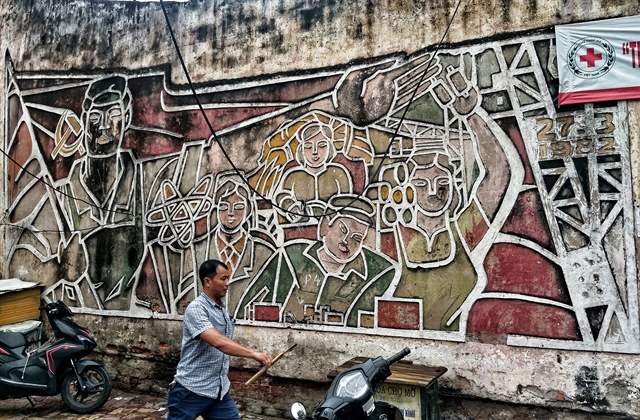HÀ NỘI --Two wall paintings made in the early 1980s at the Bạch Mai-Minh Khai crossroads in Hà Nội's Hai Bà Trưng District will soon be knocked down for a new road project.

URBAN ART: The painting by Trường Sinh in the 1980s features various labourers, including intellectuals, factory workers, farmers and soldiers. VNS Photos Đoàn Tùng
Artists and researchers have expressed outrage over the plan as the paintings are important artefacts from a historic period in the country’s development.
Researcher Khuất Tân Hưng posted images of the two paintings on his facebook page, among other relics on Đại La Street that will be destroyed for the infrastructure project.
“The two wall paintings were made by painter Trường Sinh in the 1980s,” the director of the Urban Heritage of the Architecture Faculty, Hà Nội Architectural University, wrote. “More importantly, they are the only two large paintings remaining in the city.”
Painter Trường Thành, son of painter Trường Sinh, confirmed that the two paintings, one on cement and the other a mosaic made of hundreds of ceramic pieces, were made in 1983-84.
Before those pieces, his father made another at Ô Chợ Dừa Junction – a busy area in Hà Nội.
A bronze basrelief featuring intellectuals, factory workers, farmers and soldiers was erected at Yên Phụ Junction.
“I think all paintings have a place in history,” architect Nguyễn Trương Quý, who has written various essays on the city, told Thanh Niên (Young People) newspaper in an interview. “They are evidence of a historic period that researchers would appreciate. Taking the genre into consideration, this is a rare kind of urban art work in Hà Nội.”
Writer Nguyễn Ngọc Tiến said that the most important value of the paintings is their meaning praising various labourers.
Architect Quý said the two paintings shows construction and materials of the 1980s.
The mosaic made with pieces of coloured tiles features a woman in áo dài (traditional long dress), expressing romance and optimism in the country's economic difficult period, Quý said.
“They are representatives of a time that still influences today’s Hà Nội,” he said. “They are works of street art.”

PIECE OF HISTORY: The painting made of colourful pieces of tiles featuring a woman in áo dài.
Architect Hưng said the two paintings marked a development period of establishing socialism in Việt Nam.
“People are busy doing something else and do not care about the value of the two paintings,” Hưng said. “They are beautiful if we compare them to today’s ceramic road along the Hồng (Red) River dyke.”
Quý suggested keeping the whole wall with the paintings on and moving them to a museum or park.
“They are still in good condition,” Quý said. “I think moving the walls with the paintings to a new space is worth doing and will reflect our attitude to the city’s history.”
Researcher Hưng suggested keeping the paintings as they are.
“If necessary we can organise a contest to design an island, even in the middle of the new road,” he said. VNS